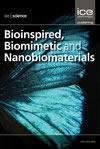Facile fabrication of Luffa cylindrica-assisted 3D hydroxyapatite scaffolds
IF 0.6
4区 工程技术
Q4 ENGINEERING, BIOMEDICAL
引用次数: 0
Abstract
The incidence of bone-related disorders is abruptly increasing worldwide, and the current therapies available are not sufficient to fulfill the growing demands of patients. Porous three-dimensional (3D) structures cast in combination with ceramics and polymers, with an intention to mimic native bone tissues, are gaining importance because of their better physicochemical and biological activities. The purpose of this study is to prepare a porous scaffold using Luffa cylindrica (LC) as a template coated with hydroxyapatite and gelatin. Guar gum (GG) was used as a binder, and hydroxyapatite powder was added to slurry of 10% gelatin and 1% GG in which pieces of LC were dipped followed by sintering at 900°C. The fabricated scaffolds (LC-GG) were analyzed by using different characterization techniques along with evaluation of porosity and water retention ability. The results revealed that the as-formed scaffolds have 70% porosity with more than 90% water retention ability. The degree of spreading of lymphocytes over the scaffold surface was less in comparison with that of the control, which showed the immunocompatibility of the fabricated scaffold. Based on the aforementioned findings, it is assumed that the synthesized porous structures can suitably be used for biomedical applications.丝瓜辅助羟基磷灰石三维支架的制备
骨相关疾病的发病率在世界范围内急剧增加,目前可用的治疗方法不足以满足患者日益增长的需求。多孔三维(3D)结构与陶瓷和聚合物相结合,旨在模仿天然骨组织,由于其更好的物理化学和生物活性而变得越来越重要。本研究以丝瓜为模板,包被羟基磷灰石和明胶制备多孔支架。以瓜尔胶(GG)为粘结剂,将羟基磷灰石粉末加入10%明胶和1% GG的浆液中,蘸取LC片,900℃烧结。采用不同表征技术对制备的LC-GG支架进行了分析,并对其孔隙率和保水能力进行了评价。结果表明,支架的孔隙率为70%,保水能力大于90%。与对照组相比,淋巴细胞在支架表面的扩散程度较低,表明支架具有免疫相容性。基于上述发现,假设合成的多孔结构可以适当地用于生物医学应用。
本文章由计算机程序翻译,如有差异,请以英文原文为准。
求助全文
约1分钟内获得全文
求助全文
来源期刊

Bioinspired Biomimetic and Nanobiomaterials
ENGINEERING, BIOMEDICAL-MATERIALS SCIENCE, BIOMATERIALS
CiteScore
2.20
自引率
0.00%
发文量
12
期刊介绍:
Bioinspired, biomimetic and nanobiomaterials are emerging as the most promising area of research within the area of biological materials science and engineering. The technological significance of this area is immense for applications as diverse as tissue engineering and drug delivery biosystems to biomimicked sensors and optical devices.
Bioinspired, Biomimetic and Nanobiomaterials provides a unique scholarly forum for discussion and reporting of structure sensitive functional properties of nature inspired materials.
 求助内容:
求助内容: 应助结果提醒方式:
应助结果提醒方式:


